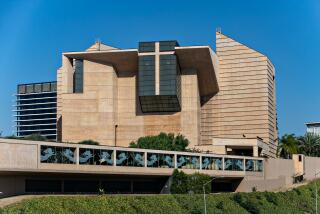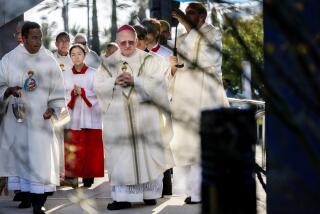Legal clash over church property
SAN DIEGO — In an unusual confrontation between church and state, San Diego Roman Catholic Bishop Robert H. Brom was grilled for hours Friday by a bankruptcy trustee, lawyers and seven victims of sexual abuse by Catholic clergy.
In a federal courthouse, Brom and church officials were clearly on the defensive as U.S. Trustee Steven Jay Katzman repeatedly questioned items in bankruptcy papers filed by the church in the face of 150 damage claims by sexual abuse victims.
Officials, led by Brom, answered “I don’t know” dozens of times as they were questioned about the adequacy of the church’s disclosures in U.S. Bankruptcy Court, where it is seeking to reorganize. The hearing was a bankruptcy procedure in which the debtor is confronted by creditors about the value of property involved in the case.
In the sometimes testy appearance, Brom, who has been a bishop for 24 years, was flanked by lawyers and church officials as he answered quietly, never taking notes.
Brom led off six hours of testimony by explaining why the bankruptcy, filed immediately before a jury was to consider church liability in abuse cases, was the proper course.
“This approach will be the best for all of the victims involved. And it will be one which will respect the mission of the church, which needs to continue,” Brom said. “We hope to accomplish a fair and equitable response to all of the victims while not crippling the ability of the church to continue its mission,” the bishop said.
Under questioning, church officials acknowledged many differences in the three versions of church financial statements they have filed so far. They promised to do a better job in valuing the church’s real estate and took issue with one portion of a professional audit done on diocesan books last summer.
Across the room, a dozen lawyers for victims sought to maximize diocesan assets that would be available to pay damages to the victims.
Brom only showed annoyance once, when a lawyer asked about discrepancies between the church’s first financial disclosures it filed in February, and two later amendments, the most recent filed less than 24 hours before the hearing.
“Are you aware that property was left off your schedules, but the debts were put on your schedules?” asked Andrea Leavitt, a lawyer who has for years represented victims in the church litigation.
The top church lawyer, Susan Boswell, interrupted, pointing out that Brom had not personally signed the first two statements, only the last.
“I didn’t review it with that kind of detail because I don’t have that kind of knowledge,” Brom said. He read aloud from the oath he signed, declaring the financial statements to be “true and correct to the best of my knowledge information and belief. I have to trust counsel,” he said.
When Leavitt pressed further, Brom bristled.
“There is an insinuation that I’m not telling the truth,” Brom said, his voice rising. “And I don’t like that and I want to say it clearly.... “
San Diego is the fifth of the nation’s of 195 Roman Catholic dioceses to file for bankruptcy protection. The church is not insolvent, but it chose to reorganize under federal law when faced with a potentially crushing financial burden brought on by the sex abuse cases. The bankruptcy lawsuit in effect freezes all the other litigation against it. The church had proposed a $95-million settlement for the 150 victims, a sum that plaintiffs rejected.
The value of church property is key to the case. Katzman did not hesitate to pressure officials for an explanation of how they figured its value at $96 million. He noted that of the 34 diocesan properties, only two were figured by market value, while the remainder was based on appraised value or the purchase cost for parcels acquired 60 years ago.
Brom asserted that land of the diocese’s parishes are held “in trust” by the diocese for the benefit of the individual churches.
But other church officials acknowledged there is no notation on property deeds that the land listed as owned by the diocese is held in trust for the parishes.
Church assets available for abuse victims would increase significantly if the trustee finds that parish property -- there are 98 churches -- belongs to the diocese.
Boswell repeatedly cited attorney client privilege in directing Brom and others not to answer questions. At one point, victims’ lawyer Irwin Zalkin questioned the $2.2-million value listed for one piece of property, saying he had a document that showed a developer had offered $31.4 million for it last year. Boswell said the data were revealed through “inadvertent disclosure” and directed church officials not to talk about them.
Other church bankruptcies have spent one to 2 1/2 years dealing with arguments over property ownership and value.
When Katzman, the trustee, noted that an annual audit of church finances last June omitted $38 million in stocks and bonds that were listed in the bankruptcy papers, the diocesan controller, Karen Jassoy, responded: “In light of everything, I don’t believe that the June 30 statements are correct.”
More to Read
Sign up for Essential California
The most important California stories and recommendations in your inbox every morning.
You may occasionally receive promotional content from the Los Angeles Times.










